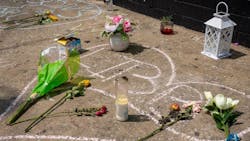Should businesses prepare for potential shootings?
A shooting at a Kansas City nightclub over the weekend that killed three people and critically injured two more is one of more than 200 mass shootings that have happened in the U.S. this year — in places ranging from schools to malls.
To help staff at local bars like the Klymax Lounge and other businesses feel prepared in case a violent incident happens on their premises, Kansas City police and fire departments are offering ongoing active shooter and CPR training as a resource.
“The goal is to be preventative,” said KCPD officer Alex Saragusa during a training earlier this year. “In an active shooter situation, seconds matter, and giving them the opportunity to know how to apply tourniquets, give CPR and give vital first aid can save lives.”
The Kansas City Police Department has provided active shooter training to organizations since 2007, and the sessions are free to the public.
“We encourage any business or organization to take advantage of this training to create situational awareness for their staff and employees,” officer Corey Carlisle said in an email.
So far in 2023, at least 86 people have died by homicide in Kansas City, many of which were shooting deaths, according to a review done by The Star.
Gun violence in and around Kansas City’s bars and entertainment districts have area officials grappling with how to prevent the violence.
In 2018, the Westport Entertainment District began requiring safety scans for weapons for anyone entering the area after 11 p.m. on Friday and Saturday nights during warmer months. Despite the aggressive security measures, the entertainment district has still faced challenges with gun violence.
What do active shooter trainings include?
KCPD’s active shooter training includes a one-hour PowerPoint presentation, a video presentation and a physical structural assessment. The entire session can take anywhere between one to three hours depending on the size of the business and staff, according to Carlisle.
Lessons can also tackle things like how to apply a tourniquet to stop any excessive bleeding and strategies for emergency planning.
“Each situation is different, but understanding your options and being aware of the physical layout of your facility, or being aware of all avenues to flee, in an outdoor environment, are all part of planning for a response to an active shooter,” Carlisle said in an email.
The fire department also holds CPR training that can be useful after a shooting.
Jimmy Walker, the KCFD assistant fire chief, said many people think they need a special certification or need to give mouth-to-mouth to administer CPR, but there are some basic, hand-only approaches to CPR that anyone can use to save a life.
“What our goal is, is to get everyone in our city trained on the hands-only CPR technique, there’s no licensure that goes with it,” Walker told The Star previously. “The sooner that we can address somebody when they go into cardiac arrest, the higher the likelihood of them surviving that incident.”
How to sign up your business or group for active shooter training
If you are part of a group that is interested in setting up a similar training, you are welcome to contact KCPD. The department hosts about 75 to 100 active shooter training in the community every year, according to Schramm.
To schedule, email Sergeant Steve Schramm at [email protected].
KCFD also offers training to community groups and businesses. To request a CPR training, fire drill, or any other kind of service, call 816-513-4632. You can also submit a request here.
Tips for planning for an emergency or active shooter
KCPD Sergeant Steve Schramm told The Star previously that there are two main tips for anyone concerned with being prepared for an active shooter situation: Know where your exits are and how to get to them, and take note of any rooms that could be good for hiding or barricading.
New York City’s police department regularly publishes a best practices guideline for nightclubs and bars. Some of the suggestions include:
Have at least one security guard for every 75 people.
Install policies that require security to lawfully remove any patrons that exhibit violent behavior.
Make sure cameras are properly working and maintained and mounted in the front of the business.
Make sure lighting is sufficient so security guards can observe the environment and see all the patrons.
If there are metal detectors, make sure every single patron is scanned, including staff, promoters and VIP guests.
©2023 The Kansas City Star. Visit kansascity.com. Distributed by Tribune Content Agency, LLC.
